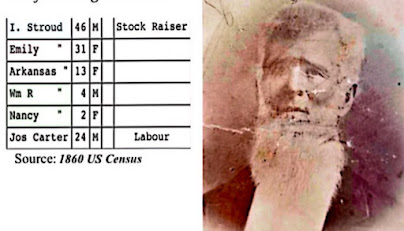By 1772 tensions between the White Settlers and the Native Tribes were on the rise. Many atrocities were committed along the border in the years leading up to Lord Dunmores War in 1774. Especially effected by Indian hostilities were the German Communities of the Virginia Backcountry. The Stroud Family was apparently the first German family attacked by the Indians as noted in and excerpt from "The Report by the Society for the History of Germans in Maryland."
The following account published by the "County Commissioners Association of West Virginia" seems to be the most accurate summary of the massacre;
“While away from home in June 1772, the family of a German immigrant named Peter Stroud was murdered, presumably by Indians. The trail left by the murderers led in the general direction of Bulltown. Peter's brother, Adam Stroud, had a cabin nearby and seeing smoke rising into the sky, raced to his brother's cabin. He gathered up what was left of the bodies and buried them. He then headed for Hacker's Creek where he met with several other settlers who agreed to join him in an attack on Bulltown."
Historical maker located in Webster County, West Virginia.It is not clear exactly what Peter Stroud did or where he went after the murder of his wife and children. The only evidence of Peter Stroud after the massacre of his family is that of his own death, recorded in Chalkley's Augusta County "Chronicles" on August 28th", 1773. The cause of his death is unclear, however, given the circumstances one may draw a quick conclusion.
Today, almost 250 years later, the area surrounding the site of the massacre near the junction of Strouds Creek and the Gualey River is dotted with landmarks named for the Stroud Family. These include "Strouds Creek," two roads; "Strouds Creek Road" and "Strouds Creek Loop," a region known as "Strouds Glades," and a small unincorporated community known as "Strouds." There was also the now defunct “Stroud's Creek and Muddlety Railroad Line”.
After discovering the massacre of his brother's family most accounts agree that ti was Adam Stroud who made his way to Hackers Creek Settlement where William White, John Cutright, William Hacker, and the famous frontier scout Jesse Hughes agreed to help him track down the murders of his brother's family. The trail left by the murderers of the Stroud Family, who were later determined to have been a band of Shawnee from the Ohio Valley, led in the general direction of Bulltown. Returning two days later the group reported having seen no Indians and that Bulltown had been abandoned. However, on his deathbed in 1850, at the age of 105, John Cutright admitted that the men had massacred the entire Bulltown settlement and had thrown the bodies into the Little Kanawah River.
The first account of the Bulltown Massacre was published in "Chronicles of Border Warfare" by Alexander Withers in 1831. Withers was not certain if the story was true and gave the names of only William Hacker and William White. In 1915 Lucullus McWhorther published "The Border Settlers of Northwestern Virginia, 1768-1795". In a footnote to the Withers story, he added the account of John Cutrights deathbed confession and the names of John Cutright, Jesse Hughes, and a man named "Kettle." Some sources substitute "Kettle" with Adam Stroud.
Whether or not the Bulltown Massacre occurred is still debated by historians to this day. A writer in the historical newspaper "Awhile Ago Times", terms the entire story "A Ridiculous Tale", adding; "If these five men could attack Bulltown, where sixteen warriors were fortified in twenty cabins and they being in the open and fighting behind trees, the Squaws were no doubt loading weapons for the warriors and they all being aware of the approach of the white men, it would be a feat unheard of and unsurpassed in all history of the frontier, to believe that they could kill all sixteen of the warriors, the fifteen squaws and eight children, dump their bodies in the Little Kanawha River and never suffer wound or casualty themselves. This is unbelievable and much too much to comprehend."
Frontier historian and novelist David Begler, who is a descendant of Jesse Hughes, and with whom the author had the pleasure of corresponding, has a different view. He believes that because the Bulltown Indians were not previously considered hostile they would not have been on the alert for an attack. He also believes that Peter Stroud may have traded frequently at Bulltown and that Peter Stroud accompanied Adam Stroud to Hackers Creek and Bulltown.









No comments:
Post a Comment